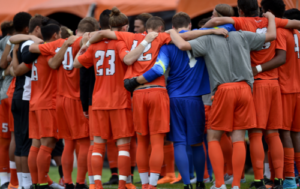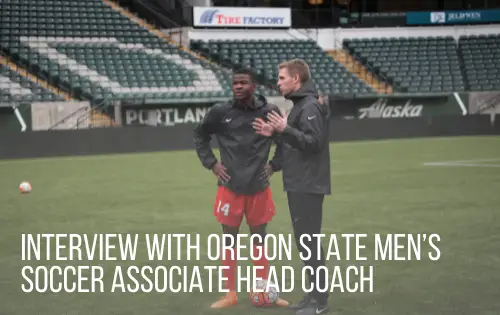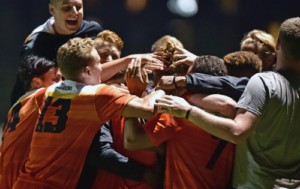Welcome to Interview #72.
I am pleased to share with you the wisdom of NCAA Men’s Associate Head Coach of Oregon State University, Ben Stoddard.
Ben Stoddard is in his third season with Oregon State. In July he was promoted to associate head coach. He is currently the youngest associate head coach in Division 1. Coach Stoddard is one of the brightest and best rising college coaches. He has been a key element in the success of Oregon State soccer.
What are some ways that recruits can get you to take an interest in them?
First and foremost, athletes need to be proactive. College soccer is not like college football where there are a dozen plus coaches at every school. Most staffs have 3 full time coaches and recruiters, with some schools only having 2. This makes seeing every player very difficult. I encourage athletes to send emails, make phone calls, attend camps, and be proactive. Once you have a staff’s attention it is about seeing if there is a fit academically, athletically, and culturally.
How early do athletes need to be noticed to have a chance to play at a major Division 1 school? When is it too late?
The process is different for everyone and every school so it is hard to give a written blueprint of how each athlete should go about the recruiting process. Prospects need to start being proactive and reaching out to schools during their sophomore year to be considered “on time”. A lot of commitments come as juniors so the earlier you start the better. That being said, it is never too late. The process is different for everyone so if you are older and haven’t started the recruiting process it doesn’t mean you shouldn’t.
How do coaching staffs at Division 1 schools work together to put together a recruiting class? Who should prospective athletes contact?
Every staff works differently on the inside so I will not speak on behalf of all 206 Division 1 programs. What most programs tend to do is split  the recruiting among the assistants with one coach overseeing it all. That coach is called the recruiting coordinator. I encourage prospects to contact the head coach and recruiting coordinator, if that information is available online. If not, contact the entire staff to be safe. There are also recruiting questionnaires that you can find on a lot of program’s website. Fill those out as well.
the recruiting among the assistants with one coach overseeing it all. That coach is called the recruiting coordinator. I encourage prospects to contact the head coach and recruiting coordinator, if that information is available online. If not, contact the entire staff to be safe. There are also recruiting questionnaires that you can find on a lot of program’s website. Fill those out as well.
What are a few of the most common mistakes that prospective-student athletes make in the college recruiting process?
Prospects tend to believe that they will be found based on their ability. Sometimes that is the case at the highest club, academy, or youth national team levels but most of the time it doesn’t work that way. Athletes need to do their own research, see which schools are the best fit and then proactively contact the coaches with their schedules, academics, and background.
The other mistake I see a lot is prospects believing soccer is their ticket to college regardless of their academics. That is not the case. We have to pass on recruits every year because they did not take school seriously and don’t have the grades to get in and/or meet the NCAA minimum requirements.
How do you use social media when recruiting? What is your advice to recruits about social media?
Social media is used as a recruiting tool for most college coaches nowadays. It is a way to get in touch with recruits, but maybe more importantly see who the kids are and what they are about. My advice to prospects is to be responsible with what they post. Of course they should have fun with it but remember that people are always watching and what they post online will reflect on the type of person they are.
What are some things that would keep you from recruiting a player?
Assuming the athlete meets our criteria from an athletic and academic perspective the biggest thing that would prevent us from recruiting someone is what he is like off the field. We take a lot of pride in the culture of our program and the quality of guys we have in our team room. We also take a lot of pride in our program’s impact on the community. If we feel that an athlete doesn’t positively impact our culture we will not pursue him, regardless of what he does on the field and in the classroom.
There is a misconception about how “athletic scholarships” are the golden ticket to pay for college, especially at the Division 1 level. Could you share, in whatever detail you are comfortable, what the athletic scholarship break down looks like on your roster and what is allowed by the NCAA Division 1?
NCAA Division 1 Men’s Soccer is allowed a maximum of 9.9 scholarships. Those can be broken up in whatever way we as a staff see
fit. That said, 9.9 scholarships spread pretty thin among 28-30 student-athletes. We talk in 3rds as a general rule. There is a 3rd of our team on a lot of athletic scholarship, a 3rd of our team on a little athletic scholarship, and a 3rd of our team on no athletic scholarship.
There are very few players across the country that get a completely “full” athletic scholarship so that is another reason why prospects should put an emphasis on their academics. A lot of schools can package both athletic and academic scholarships to help lower the costs. That is something to ask about when speaking with different schools.
What else is important to affording college besides the “athletic scholarship”?
There are a lot of ways you can cut costs (specifics depending on the university obviously). There are scholarships often involved with extra circular activities (i.e. church, camps, academic groups, etc.). Prospects can also look at taking online classes and living off–campus, both of which can be cheaper than living in university housing and taking regular classes. I would recommend prospects talk their high school guidance counselor about other ways to help lower costs as well.
How do college athletic programs interact with student athletes to help them manage academics and the demands of their sport?
This is university specific. At bigger Division 1 programs like Oregon State, we have a full-time academic coordinator. Our athletes work daily with our academic coordinator on their schedules, tutoring needs, study groups, communication with professors, and whatever else might be needed.
Our academic coordinator then serves as the liaison between our staff and the players. It is a fantastic set up that allows for both accountability and support for our student-athletes. Prospects should ask questions about this when they communicate and/or visit universities because all schools deal with this differently, many without an academic coordinator/supervisor.
What should a recruit look for specifically on a campus visit?
They need to make a priority list of what is important to them. This is different for everyone. Once they know what their needs and wants are they can visit and get a feel for the overall vibe both on and off campus. Look at the relationships with the staff and the players and see if it is a positive environment that they could thrive in. They should also look at the logistical pieces like how they work academics, how they train, what their daily schedule is like, what majors are offered, if any student development programs are available for them to graduate and go right into the professional world, etc.
What is the role of the parent in the recruiting process?
Parents need to let their child take the reigns. College coaches are recruiting their kid so they should mainly be communicating with their kid. Many parents are so eager to help that they actually get in the way of the natural relationships built through the recruiting process. Outside of being supportive, they need to be honest about the finances so as their child narrows down his favorite colleges they are aware of what they can and cannot afford.
You have a unique perspective because you have played and coached at the NCAA Division 1 and NAIA levels. I would like to ask you to help prospective athletes understand some of the differences to look for.
I have been fortunate to see a lot of different sides of the college game both as a player and a coach. I believe there is a place for everyone but you have to really do your research to find it.
It might be surprising coming from me, but Division 1 is not the best fit for every kid. The NAIA is a great level with great universities associated with it so there is nothing wrong with going to an NAIA school. As is the case with Division 2 and 3 levels. Each prioritize things a bit differently.
The Division 1 level is the highest level competitively so soccer is going to be a lot of work and very time consuming.
Division 2 is a little bit less of a competitive focus than D1 but still a very good level with very good universities.
Division 3 is a lot less soccer outside of the fall season and much more academic focused.
The NAIA has a bit less restrictions so it is more dependent on what the individual university’s focus and priorities are. It is also a very high level competitively, as I mentioned above.
The other big differences between all 4 levels is the scholarships. Each Division has a maximum amount of athletic scholarships allowed but not every school has the maximum allotment at their disposal. Division 3 does not have any athletic scholarship available but there are a lot of opportunities to earn academic money.
One thing I do not mention above that is an excellent option for many prospects is the Junior College route. This gives 1-2 years for student-athletes to develop, bring their grades up, find the right 4-year college fit, etc. There are a lot of success stories of kids going the JUCO route then transferring to a 4-year program and doing very well.
What are differences between playing and the college experience at the Division 1 or NAIA levels?
The day to day schedule and the competitive environment are the 2 biggest differences for me. The Division 1 level is very time consuming and detail oriented. There also tends to be a lot more depth from top to bottom on each roster.
How does a player know if they are a division 1 athlete or if they should look toward another level of play?
Be honest with themselves and the feedback given. Go to camps, talk to your coaches, look at the different levels around the country and be honest with the evaluations and feedback given.
Bonus Question: Is there anything important that you would like to share directly with high school athletes or soccer players in particular as they navigate the recruiting process?
Have fun! There is a lot of information thrown at you during the process and because it is a big decision many get overwhelmed with it. Take it seriously but make sure to enjoy it and have fun. You are very fortunate to have the opportunity to play college soccer so make sure you enjoy the process of deciding where that will be.
Profile:
Ben Stoddard is in his third season with Oregon State, and his first in  the role of associate head coach.
the role of associate head coach.
Stoddard, a graduate of Indiana Wesleyan University (IWU), assisted the IWU men’s soccer program from 2012-2014. He worked in all facets, helping lead IWU to their two best seasons in program history.
Next, check out: An Athlete’s Simple Start to a College Search
LIKE WHAT YOU READ?
Please take a moment to share this on social media to benefit other prospective college athletes, by clicking on the “sharing is caring” buttons below.
Thanks,
Bryan



